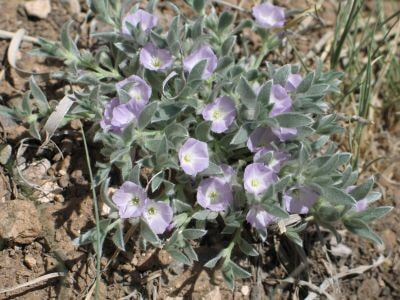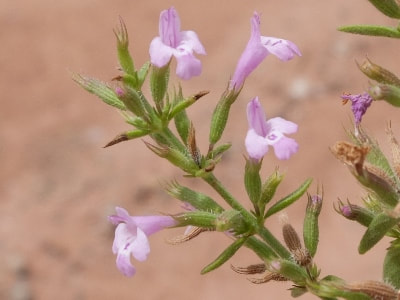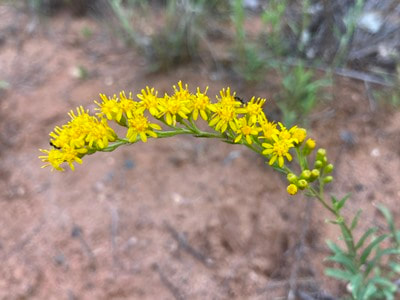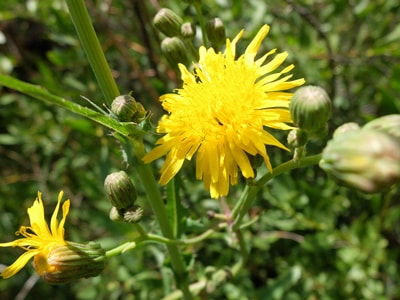Narrowleaf Four O'Clock, Umbrellawort,Mirabilis linearis,Four O'Clock Family (Nyctaginaceae)8/26/2022 Found in dry meadows, roadsides
Seen blooming in August near Hwy 554, Abiquiu Narrowleaf Four O'Clock grows to 40 inches tall in clumps with an open spreading habit. Leaves are long, narrow and grayish-green up to 4 inches long. Funnel-shaped flowers are ½ inch across with showy stamens and range from white to pink to purple, growing in clusters of three. The leaves and stems are covered in fine hairs. Each small cluster of flowers is surrounded by a bell-shaped involucre which is pale green, sticky-hairy and sometimes purple-tinged. In fruit this inflates and becomes papery and veined and one inch across, resembling a tiny umbrella which gives it another common name, Umbrellawort; wort is an old English name for plant. Traditionally, fruits and seeds were used for food; an infusion of roots was used to treat painful urination, stomach disorders, coughs, and burns. It was also used ceremonially as a life medicine and for good luck in trading or hunting. Source. If you are trying to identify a different flower then you can check what other flowers bloom this month. If you cannot identify a flower from the website, send a photo and where you took it to [email protected]. Read online for tips.
0 Comments
Found on dry, sandy slopes
Seen blooming in August on the Madera Trail, Santa Fe NF This tiny wildflower has a very big name, which for me conjures up a character in a fairy tale. Shaggy Dwarf Morning Glory grows 4 to 6 inches high, erect and spreading, with densely hairy greyish-green leaves. The tiny lavender blue flowers are funnel-shaped and less than ½ inch across with a large, white, 5-pointed star in the center. The flowers close in the evening and remain closed on cloudy days. The plants are wider than they are tall. Shaggy Dwarf Morning Glory can be found blooming in May and after the monsoons. The Navajo sometimes used this plant as a snuff to induce sneezing. Source. If you are trying to identify a different flower then you can check what other flowers bloom this month. If you cannot identify a flower from the website, send a photo and where you took it to [email protected]. Read online for tips. Found in dry, gravelly soil, roadsides
Seen blooming in August near Abiquiu Lake Drummond's False Pennyroyal grows with many branches from a few inches to 15 inches high covered in hairs. Leaves are narrow and smell of mint when crushed. Tiny flowers grow from the leaf axils and are no more than ½ inch long. Flowers are rose-pink to pale lavender with purple streaks and a white throat. Traditionally, it was used as an analgesic; taken for influenza; and the leaves used to flavor soup. Source. If you are trying to identify a different flower then you can check what other flowers bloom this month. If you cannot identify a flower from the website, send a photo and where you took it to [email protected]. Read online for tips. Found in moist areas, hillsides, meadows, openings
Seen blooming in late July near the Rio Chama, Abiquiu Goldenrods, the Solidago genus, are differentiated by their tiny yellow flowers growing in clusters, usually on one side of the stem, or in a pyramid, and their leaves. Velvety Goldenrod grows 6 to 32 inches high in colonies from a basal rosette of leaves that are sometimes still present at flowering time. The leaves get progressively smaller higher up on the stem. Each leaf has three prominent veins running from the base to near the tip. Flowers grow on one side of the branch and have 6 to 12 petals. Flower heads can be pyramid-shaped with many arching branches or have only one branch. The name Solidago means "to make whole" and its healing properties are used to treat problems with the kidneys, urinary tract, skin, allergies, and the cardiovascular system. Source. Traditionally, Native Americans used it to treat burns, sores and wounds, for toothaches, and as a hair wash to prevent hair loss. Source. Goldenrod is an excellent source for a dark yellow dye. Found in disturbed sites, pastures, roadsides
Seen blooming in July near the Rio Chama, Abiquiu The Field Sowthistle looks like a very tall Dandelion. It grows to 3½ feet tall with hairless stems that produce a milky juice when broken. Most of the leaves are on the lower part of the stem and have prickly teeth along the edges. Flowers grow in an open branched cluster of several flower heads at the top of the stems, not all open at the same time. Flower heads are up to two inches across. It is considered a noxious weed in some states. The leaves, flowers and roots are edible. These are best consumed when the plant is young because the older it gets the more bitter it becomes. Leaf spines need to be removed. Source. Native Americans took an infusion to calm nerves and hunters sucked the milk from branches to imitate the sound of a fawn nursing, to draw the doe nearby. Source. If you are trying to identify a different flower then you can check what other flowers bloom this month. If you cannot identify a flower from the website, send a photo and where you took it to [email protected]. Read online for tips. |
AuthorI am Marilyn Phillips, a native of England, whose love of nature and the outdoors from childhood brought me by a circuitous route to Crested Butte, Colorado in 1993 and 16 years later to northern New Mexico. My exploration of the many trails in these areas, my interest in wildflowers and photography, and career in computer system design came together in this creation. If you have any corrections, comments or questions, please contact me by email. Archives
September 2025
Categoriescopyright © 2020
|







 RSS Feed
RSS Feed